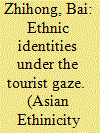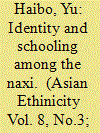| Srl | Item |
| 1 |
ID:
079633


|
|
|
|
|
| Publication |
2007.
|
| Summary/Abstract |
This paper explores transnational trade carried out by the Tai, an ethnic nationality spread across the border area between Shan State in Myanmar and Dehong Prefecture in Yunnan province in China. The Tai who live in this border region belong to a linguistic group that has long shared cultural and linguistic traits with the Thai in Thailand and other Tai-speaking groups in Vietnam, Laos and other parts of Southeast Asia. This paper focuses on the Tai peddlers who conduct trade between Thailand and Shan state in commodities such as Thai and Tai traditional clothing and entertainment VCDs featuring Shan and Thai songs. The focus is on peddling in traditional Thai dress styles that are popular with Dehong Tai customers. The author contends that dress practices have gained a meaning and status in displaying acquired wealth, and this has resulted in shifting status hierarchy among members of Dehong Tai society. Wearing certain clothes becomes a self-identification that the Dehong Tai use to manifest their social position in public. This in turn helps them to destabilize both their lower-status position in the Han-dominated Chinese society and the cultural imbalance between themselves and the Chinese.
|
|
|
|
|
|
|
|
|
|
|
|
|
|
|
|
| 2 |
ID:
079635


|
|
|
|
|
| Publication |
2007.
|
| Summary/Abstract |
This paper examines the construction of Bai ethnicity and Bai identity on the tourist market in Dali, Dali Bai Autonomous Prefecture, Yunnan, China. Focusing on how the social landscape of Dali has changed in response to the development of tourism, this paper explores how Bai ethnicity is advocated as a product loaded with potential economic values. The author discovers that 'commerce of authenticity' (T. Oakes, Tourism and modernity in China. London, Routledge, 1998), and different forms of ethnicity and artefacts promoted in the tourist market have not drowned out the sense of being ethnically Bai. Instead, the tourist industry has become a daily reminder of ethnicity to both insiders and outsiders by making people more self-conscious and reflexive about the 'cultural stuff' that they may have previously taken for granted, or may have left unattended. This paper demonstrates how locals actively appropriate state-defined categories and reshape them into the repertoire they desire
|
|
|
|
|
|
|
|
|
|
|
|
|
|
|
|
| 3 |
ID:
079634


|
|
|
|
|
| Publication |
2007.
|
| Summary/Abstract |
This paper examines the role of schooling in constructing identity of Naxi secondary students in Lijiang, southwest China. The study shows that the school assigns an identity of the Chinese nation to Naxi students, while it also plays a role in forming their ethnic identity. The school curriculum, teachers' teaching, and interactions among students influence the identity construction of Naxi students. A qualitative method was designed to collect data for this study
|
|
|
|
|
|
|
|
|
|
|
|
|
|
|
|
| 4 |
ID:
079644


|
|
|
|
|
| Publication |
2007.
|
| Summary/Abstract |
The statement that Xinjiang is an integral province of the People's Republic of China (PRC) is not as banal as it would first appear. The primary question that arises from this statement is how - by what processes and strategies - was Xinjiang brought to its contemporary situation as a province of the PRC? This paper seeks to highlight that, although Xinjiang's history since the eighteenth century has been one of great turbulence and dynamism, underlying continuities in both the practice of Chinese power and perceptions of Xinjiang impact profoundly on contemporary China's rule of Xinjiang. Therefore, this study attempts to chart the transition of the Qing goal of territorial incorporation of the region based upon a system of indirect rule c.1760 to the post-imperial Chinese state's goal of territorial incorporation based on the extension of direct, modern strategies of government and control
|
|
|
|
|
|
|
|
|
|
|
|
|
|
|
|